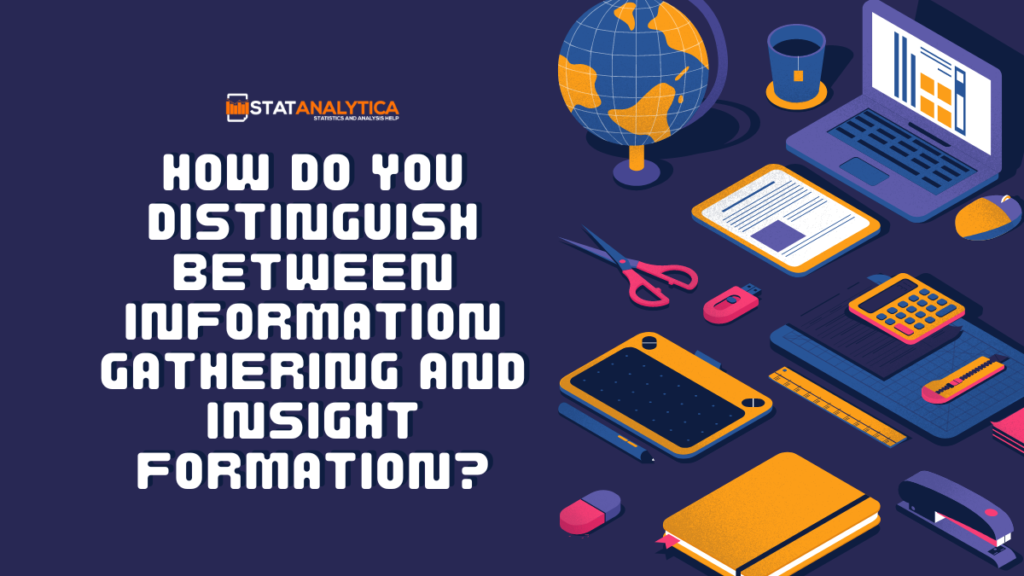In our fast-paced world, we’re constantly bombarded with data and information. Whether it’s from news articles, social media feeds, or research reports, we’re surrounded by an abundance of facts and figures. But amidst this sea of information, how do we separate the wheat from the chaff? How do we turn raw data into actionable insights? In this blog post, we’ll explore how do you distinguish between information gathering and insight formation, and why it’s essential to distinguish between the two.
Understand Information Gathering & Insight Formation With Example
Table of Contents
Information gathering
It is the process of collecting data from various sources. It involves gathering facts, statistics, and other relevant information to build a comprehensive understanding of a particular topic. This could include conducting surveys, interviews, or analyzing existing data sets.
The goal of information gathering is to gather as much relevant data as possible to inform decision-making and problem-solving.
For example, imagine you’re conducting market research for a new product. You might gather data on consumer demographics, purchasing behavior, and competitor analysis to get a complete picture of the market landscape. This information will help you make informed decisions about product development, pricing strategies, and marketing campaigns.
Insight Formation
Insight formation, on the other hand, goes beyond simply collecting data. It involves analyzing and interpreting the information gathered to uncover deeper patterns, trends, and correlations.
Insights are the “Aha!” moments that arise when we connect the dots and gain a deeper understanding of a situation.
To continue with our market research example, insight formation might involve analyzing the data collected to identify emerging trends or consumer preferences.
Perhaps you notice that there’s a growing demand for sustainable products among a certain demographic. This insight could lead you to pivot your product development strategy to capitalize on this trend, giving you a competitive edge in the market.
How Do You Distinguish Between Information Gathering And Insight Formation?
| Aspect | Information Gathering | Insight Formation |
| Focus | Collecting raw data | Analyzing and interpreting data |
| Scope | Surface-level | Deeper analysis |
| Output | Raw data and facts | Actionable insights |
| Purpose | To gather information for decision-making | To uncover patterns and trends |
| Methods and Techniques | Surveys, interviews, data analysis | Data analysis, pattern recognition |
| Outcome | Data accumulation | Strategic guidance |
Importance of Distinguishing Between Information Gathering and Insight Formation
Distinguishing between information gathering and insight formation is crucial for several reasons:
Impact on Decision Making
- Without insights, decision-makers may be overwhelmed by the sheer volume of data and struggle to make informed decisions.
Efficiency and Effectiveness
- By focusing on insight formation, organizations can streamline their decision-making processes and allocate resources more efficiently.
Value Addition
- Insights add value by providing actionable recommendations and strategic guidance, ultimately leading to improved outcomes and competitive advantage.
Practical Examples To Distinguishing Between Information Gathering and Insight Formation
Let’s look at some real-world examples to illustrate the difference between information gathering and insight formation:
- Information Gathering:
- Conducting surveys to collect customer feedback.
- Analyzing sales data to track revenue trends.
- Gathering market research reports from industry publications.
- Insight Formation:
- Identifying patterns in customer feedback to improve product design.
- Analyzing sales data to uncover seasonal trends and optimize inventory management.
- Synthesizing market research reports to identify emerging market opportunities.
Strategies for Enhancing Information Gathering and Insight Formation
To enhance information gathering and insight formation, consider the following strategies:
Improving Data Collection Techniques
- Combine different ways of gathering information, including asking people’s opinions and looking at numbers, to get a variety of viewpoints.
- Leverage technology tools such as data analytics software to streamline data collection and analysis processes.
Enhancing Analytical Skills
- Encourage your employees to improve their analysis abilities by investing in training.
- Create an environment where curiosity and critical thinking are valued in your company.
Integrating Technology Tools
- Discover new technologies like artificial intelligence and machine learning to find valuable information in big sets of data.
- Invest in data visualization tools to communicate insights effectively to stakeholders.
What Are The Best Tools For Information Gathering and Insight Formation?
There are various tools available for both information gathering and insight formation, catering to different needs and preferences. Here’s a list of some popular tools for each:
Information Gathering Tools
- SurveyMonkey: Ideal for creating and conducting surveys to gather feedback from respondents.
- Google Forms: Free tool for creating customizable forms and surveys, with easy data collection and analysis features.
- Web Scraping Tools (e.g., BeautifulSoup, Scrapy): Useful for extracting data from websites and online sources automatically.
- Social Media Listening Tools (e.g., Hootsuite, Brandwatch): Allow monitoring and analysis of social media channels to gather insights on audience sentiments and trends.
- Market Research Platforms (e.g., Nielsen, Kantar): Provide access to comprehensive market data and reports for in-depth analysis.
Insight Formation Tools
- Data Analytics Platforms (e.g., Google Analytics, Tableau): Enable visualization and analysis of data to derive insights and make data-driven decisions.
- Statistical Software (e.g., R, SPSS): Ideal for performing advanced statistical analysis on datasets
to identify patterns and correlations. - Machine Learning Tools (e.g., Python libraries like TensorFlow, scikit-learn): Utilized for predictive analytics and uncovering complex patterns in large datasets.
- Text Mining and Natural Language Processing (NLP) Tools (e.g., NLTK, spaCy): Assist in analyzing text data, such as customer reviews or social media comments, to extract insights.
- Business Intelligence (BI) Platforms (e.g., Power BI, QlikView): Provide interactive dashboards and reporting capabilities for visualizing and exploring data to gain insights.
Integrated Platforms
- Microsoft Excel: Offers a wide range of functionalities for both data collection (e.g., forms, data entry) and analysis (e.g., pivot tables, charts).
- Google Workspace (formerly G Suite): Includes tools like Google Sheets (for data collection) and Google Data Studio (for visualization and analysis), facilitating a seamless workflow from gathering to forming insights.
- Customer Relationship Management (CRM) Systems (e.g., Salesforce, HubSpot): Allow businesses to collect and analyze customer data to gain insights into customer behavior and preferences.
Conclusion
In today’s data-driven world, it’s more important than ever to know how do you distinguish between information gathering and insight formation. While information gathering lays the foundation by collecting raw data, insight formation is the key to unlocking its true value.
By focusing on insight formation, organizations can turn data into actionable insights that drive innovation, growth, and success. So the next time you’re drowning in data, remember to look beyond the numbers and seek out the insights that truly matter.


